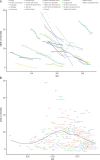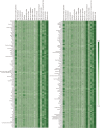Epidemiological trends of subarachnoid hemorrhage at global, regional, and national level: a trend analysis study from 1990 to 2021
- PMID: 38992778
- PMCID: PMC11241879
- DOI: 10.1186/s40779-024-00551-6
Epidemiological trends of subarachnoid hemorrhage at global, regional, and national level: a trend analysis study from 1990 to 2021
Abstract
Background: Subarachnoid hemorrhage (SAH) is a subtype of hemorrhagic stroke characterized by high mortality and low rates of full recovery. This study aimed to investigate the epidemiological characteristics of SAH between 1990 and 2021.
Methods: Data on SAH incidence, mortality, and disability-adjusted life-years (DALYs) from 1990 to 2021 were obtained from the Global Burden of Disease Study (GBD) 2021. Estimated annual percentage changes (EAPCs) were calculated to evaluate changes in the age-standardized rate (ASR) of incidence and mortality, as well as trends in SAH burden. The relationship between disease burden and sociodemographic index (SDI) was also analyzed.
Results: In 2021, the incidence of SAH was found to be 37.09% higher than that in 1990; however, the age-standardized incidence rates (ASIRs) showed a decreased [EAPC: -1.52; 95% uncertainty interval (UI) -1.66 to -1.37]. Furthermore, both the number and rates of deaths and DALYs decreased over time. It was observed that females had lower rates compared to males. Among all regions, the high-income Asia Pacific region exhibited the highest ASIR (14.09/100,000; 95% UI 12.30/100,000 - 16.39/100,000) in 2021, with an EPAC for ASIR < 0 indicating decreasing trend over time for SAH ASIR. Oceania recorded the highest age-standardized mortality rates (ASMRs) and age-standardized DALYs rates among all regions in 2021 at values of respectively 8.61 (95% UI 6.03 - 11.95) and 285.62 (95% UI 209.42 - 379.65). The burden associated with SAH primarily affected individuals aged between 50 - 69 years old. Metabolic risks particularly elevated systolic blood pressure were identified as the main risk factors contributing towards increased disease burden associated with SAH when compared against environmental or occupational behavioral risks evaluated within the GBD framework.
Conclusions: The burden of SAH varies by gender, age group, and geographical region. Although the ASRs have shown a decline over time, the burden of SAH remains significant, especially in regions with middle and low-middle SDI levels. High systolic blood pressure stands out as a key risk factor for SAH. More specific supportive measures are necessary to alleviate the global burden of SAH.
Keywords: Disability-adjusted life-years (DALYs); Global Burden of Disease Study (GBD) 2021; Incidence; Mortality; Subarachnoid hemorrhage (SAH).
© 2024. The Author(s).
Conflict of interest statement
The authors declare that they have no competing interests.
Figures



References
MeSH terms
LinkOut - more resources
Full Text Sources

